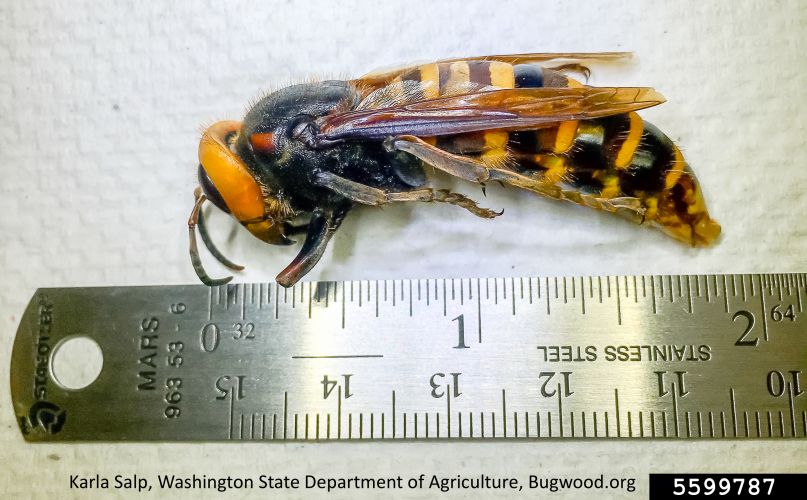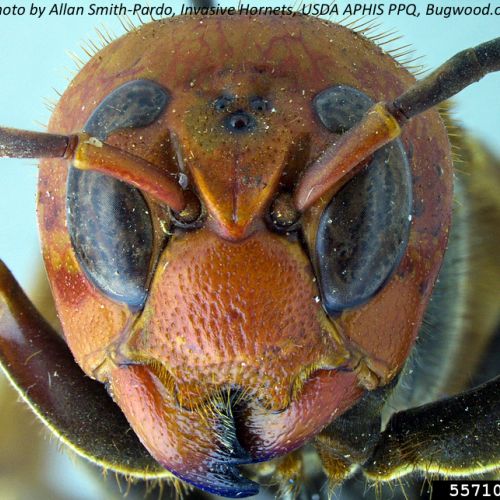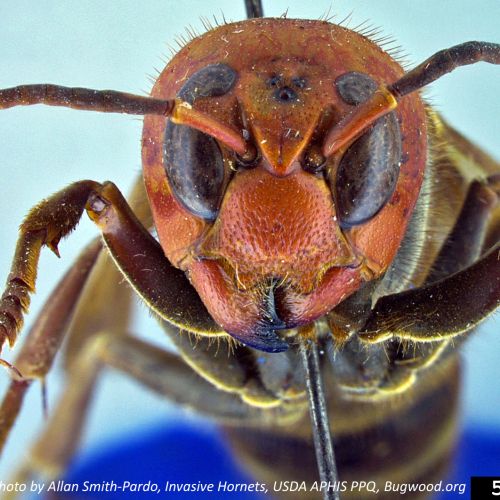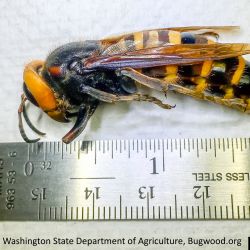
Priority: Prevent
General: Very large hornet, black eyes and orange head.
Size: Queens can be 4-5cm in length. Workers are about 3.5cm. Wingspan is between 4 and 7cm
Colour: Orange head, black eyes, alternating black and yellow to orange stripes on abdomen. Legs are dark.
Special Features: It is the world’s largest species of hornet.
Japanese giant hornet
BC has 4 large insects that are often confused with Asian Giant Hornet: Bald faced hornet, Yellow jacket, Horntail wasp, Elm Sawfly.
Differences: The major differences are a combination of colour, size and features. The Horntail wask has a similar coloured face but has a large tail that is not a stinger. The legs are also a light colour. Photos of these species can be found on the BC Ministry of Agriculture Fact Sheet (link in the Resources).
Where did it come from? Asia, south China and parts of Korea.
Where does it live here? Three Asian Hornets were found in the Nanaimo area on Vancouver Island in August of 2019. In December of 2019, a nest was found and removed in Washington State. There have been reports of sightings in Langley and the Fraser Valley in 2020. They are typically dormant in the fall and winter so are unlikely to be seen during this time. They live in nests under the ground only.
Reproduction: A queen can produce between 40-25000 offspring in a season. The average number is 10000.
When does it reproduce & mature? A queen will mate in the fall and spend the winter months in a sheltered place. In the spring, the queen will find a suitable nesting site and produce about 40 eggs. It takes about 40 days for eggs to mature into adults. Late summer, the queen then produces a very large amount of eggs. Fertilized eggs become the queens of the next season and the unfertilized eggs become the males of next season.
Spreads By: DNA analysis has determined that the hornets found in BC and Washington originally came from 2 different countries: Japan and South Korea. There is no further information about how these species came to North America from these countries (Wikipedia reference, Distribution-NA)
Species Type: Insect
- Injury by stinging. Generally Asian Giant hornets are not interested in humans, pets or large animals. They hunt insects for food. If their nest is disturbed, then they will attack and sting. The venom is toxic and has been known to cause allergic reactions.
- Asian Giant hornets aggressively attack & feed on honeybees. They can destroy entire hives in only hours.
- They can feed on soft fruit and this could also impact that industry.
- REPORT all sightings. If you see a suspected hornet, report to the Invasive Species Council of BC at 1-888-933-3722 or online.
- Beekeepers can use screens or barriers to protect their hives. They should stay informed about sightings and report if they see any hornets.
Collaboration: The BC and Washington State governments are working with the Canadian Food Inspection Agency and the US Department of Agriculture to survey, detect and eradicate any known nests.
Photo Gallery


